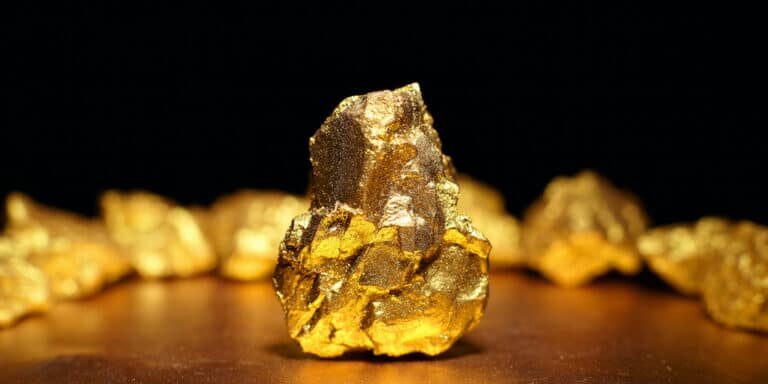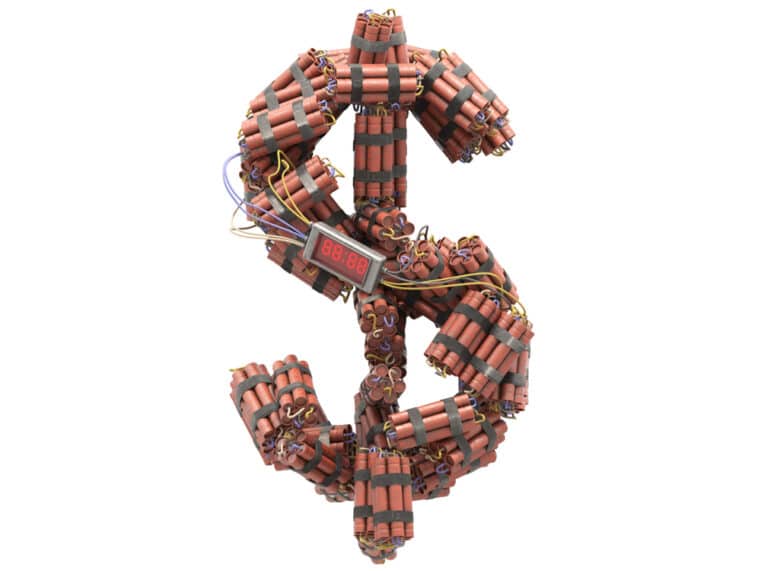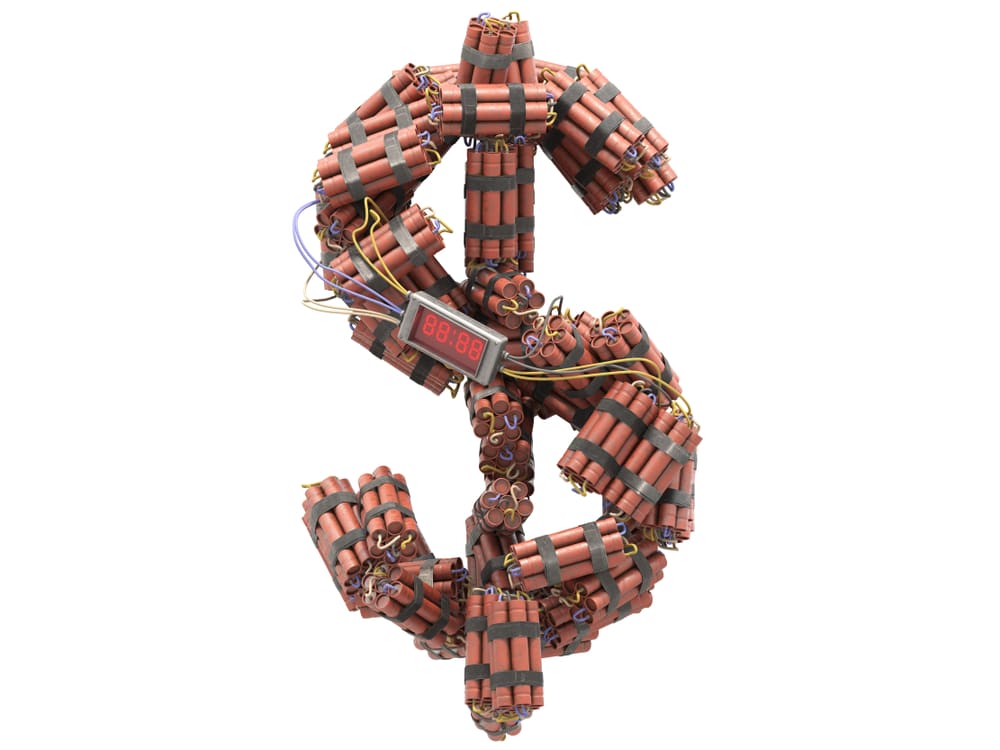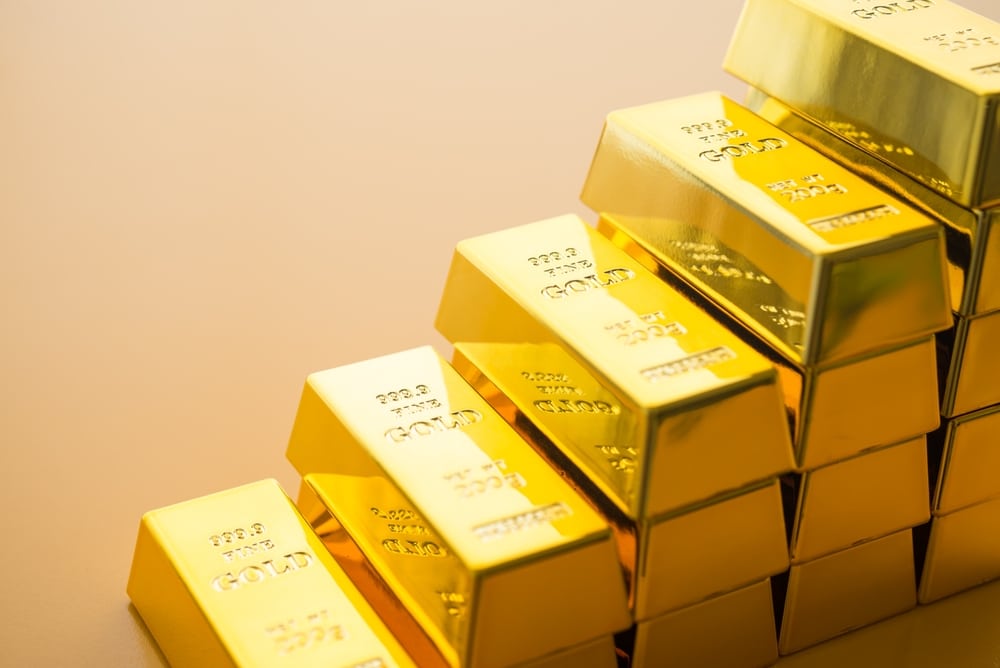
The 10 Largest Gold Nuggets Ever Found Worldwide
A gold nugget, as the name suggests, is a nugget of gold. These are pieces of gold that are found naturally. They can be found in the mining process sometimes as left-over deposits of previous gold loads. Sometimes they are found in locations where there is no hard rock gold, perhaps the most exciting of discoveries. Generally found to be 85% and 95% pure, gold nuggets are formed by a group of gold crystals from extremely heated water in the fissures of quartz.
It is thought that because the high temperatures needed to form these structures, that they are formed underground where such temperatures are found. Eventually, geological processes and weathering, shift them up to the surface where they are found by prospectors and sometimes by happenstance by extremely lucky people, in various places around the world. They can vary greatly.
Largest Gold Nuggets Found in The United States
There were smaller gold rushes in the United States, notably in the early 19th Century near Charlotte, NC and Dahlonega, GA but the real show got started in 1848 when gold was discovered in Sutter’s Mill, California. This began a seven-year gold rush that changed the nation forever. San Francisco became a boom town, people learned that you could become rich selling picks and shovels to the miners instead of mining gold yourself and the population growth in California led, in part, to it becoming a state in 1850.
1. Monumental Nugget
This is the largest gold nugget to be found in the State of California. It was discovered in Sierra County on the Sierra Buttes Mine property in 1869. Rain had exposed part of the nugget which was spotted by miners on their way to work. The Monumental Nugget weighed over 103 pounds. According to Carol Hayes, whose family purchased the Sierra Buttes Mine in 1904, miners on their way to work at the mine saw a portion of the nugget on the trail after rain had washed away the dirt that had been covering it. They quickly began unearthing the rest of the nugget and couldn’t believe their eyes when they saw the “Monumental” chunk of gold.
2. Crown Jewel Nugget
The Crown Jewel Nugget was found in 1992. This is on display at the Ironstone Vineyards in California in a custom-made vault. The 44 pound crystalline gold leaf nugget is on display with artifacts from California’s legendary 1849 Gold Rush. Found by the Sonora Mining Company, the nugget was originally enmeshed with quartz rock. Hydrofluoric acid cleaned the mostly pure gold mass. Initially, the miners believed that it was just a piece of equipment, but further investigation proved that they had discovered a huge gold in quartz specimen.
The gold was originally 66 pounds when it was purchased by the Ironstone Vineyards owner John Kautz it was etched to remove the extra, visible quartz leaving behind a 98% pure piece. The piece is now suspended inside a safe vault that visitors may walk into and view during regular operating hours.
3. Centennial Nugget
The Centennial Nugget bears the honor of being the largest gold nugget found in Alaska. It was found by Barry Lloyd Clay in 1998 on Swift Creek near the aptly named town of Ruby. The Alaskan nugget itself weighs a whopping 294 oz. - that is 20 pounds of precious metal.
Miners have been looking for gold in Alaska for more than 100 years now, and some spectacular nuggets have been found. Of all the gold found in Alaska, the Centennial Nugget is the most spectacular of all the discoveries made there. Barry Clay was a placer mining region that was known for producing big nuggets along Swift Creek. He was driving dirt with his bulldozer when his eye spotted something odd. He jumped out of the dozer, catching the ring. He knew immediately by weight that a huge gold nugget had been found. He buried the nugget under a nearby tree afterwards, until he could find out what to do with it.
As he finally took it to town for further study, it was determined he had discovered the largest nugget ever found in Alaska, and the second largest nugget ever found in the western hemisphere behind the Cortez nugget found in Mexico.

Many of the world's largest nuggets of gold were discovered in goldmines.
Largest Gold Nuggets Found in Australia
Even as recently as May 2019 people are still literally stumbling over large gold nuggets in Australia. Bendigo, Australia is home to a recent find when a young girl, out for a walk with her family and dog, literally kicked a rock and asked her father if it was gold. The exact location of the unnamed and roughly 20 oz. gold nugget find has not been disclosed because the family intends to more thoroughly search the area. One could be so lucky!
4. Little Hero
The Little Hero is the subject of the smallest issue in the first Perth Mint Australian Gold Nugget series. The coin honoring this 330 oz. natural gold nugget was 1/10 oz. The Little Hero was found in Australia in 1890.
5. Golden Eagle
The Golden Eagle was found in 1931 and weighed an incredible 1,235 oz. The nugget was found under a makeshift mining road by the son of miner Jim Latrobe. Sadly, it was sold to the Australian Government and melted. It also was the subject of the ¼ oz. issue of the first Australian Gold Nugget series.
Latrobe Sr had spent the majority of his life prospecting for gold in Western Australia, primarily around Coolgardie and the surrounding goldfields where he had found plenty of gold. One the day of the momentous find Latrobe Jr had dug less than half a meter before hitting something solid. Other diggers nearby heard a terrific yell from Latrobe and rushed to the scene to find the teenager staggering about with a massive slab of gold in his arms.
The Golden Eagle, a nugget which roughly resembles a bird with outspread wings, was a triumph for the men who dug for gold with pick and shovel. Newspapers across Australia reported the sensational discovery at Larkinville. A new gold fever set in attracting investors and many prospectors to Western Australia. Today the Golden Eagle is still the largest specimen found in Western Australia.
6. Hand of Faith
The Hand of Faith has the honor of being the largest one in history to be found with a metal detector. It was found in Wedderburn, Australia by Keven Hillier who was prospecting. This impressive nugget weighs 875 oz. - that is 61 pounds. It was buried about 12 inches underground. Even now, you can see this magnificent specimen on display at the Golden Nugget Casino in Biloxi, Mississippi. It was the subject used for the original Perth Mint Gold Nugget ½ oz. coin.
The Golden Nugget Casino in Las Vegas claims that the “Hand of Faith” nugget is the world’s largest gold nugget, but this is clearly not the case given the existence of other larger gold nuggets such as Brazil’s Pepita Canaa and Russia’s Great Triangle nuggets.
7. Welcome Stranger
The Welcome Stranger is one of the largest nuggets ever found weighing in at 72 kg which is a massive 158 pounds. It was found by the prospectors John Deason and Richard Oates on February 5, 1869 in Victoria, Australia. To put this massive gold nugget into perspective, it would be worth over $2.6 million U.S. dollars in 2019 in melt value alone. The Welcome Stranger Nugget was ultimately sold for melt value in 1869 and was presumably struck into over 9,000 British Gold Sovereign coins at the Sydney Mint.
2019 is the 150th anniversary of the Welcome Stranger which is being marked with the Perth Mint’s upcoming Welcome Stranger issues: 1 oz. .9999 fine gold coin with an ultra low mintage of 7,500; a 1 oz. .9999 fine silver coins with a low 30,000 mintage and a bronze-aluminum coin and stamp cover with a 7,500 mintage. The Perth Mint has been featuring famous nuggets on coins since 1986 when they transitioned from portraying kangaroos on the gold nugget series to incredible gold nuggets found in Australia. The series would eventually revert to focusing on the native marsupial again in 1989.
Despite such intense historical mining, Victoria is still proving to be a highly prospective region for gold mines for gold explorers today. From individual panhandlers and enthusiastic metal detector owners to the major multinational firms, Victoria continues to attract a great deal of inward investment as everyone takes up the hunt for the precious yellow metal.
Honorable Mentions Of Large Gold Nuggets
8. Pepita Canaa Nugget
This was found in Brazil. It is the biggest natural gold nugget that still exists today and is currently on display at Brazil’s Banco Central Museum. It weighs a gross 134 pounds. Gold weight is estimated to be 115 pounds. It was found in the Sierra Pelada region in Brazil in September 1983. The discovery of this historic nugget led to an eighties gold rush in Brazil.
The “Canaan” gold nugget was purchased by the Banco Central do Brazil in 1984, and is now on display in the “Gold Room'' of the central bank’s money museum in Brazil's federal capital Brasilia. Notably, the source nugget from which the Pepita Canaa nugget came was actually larger, but it split into several pieces while being removed from the ground.
In the early 1980s, Sierra Pelada became known as one of the world’s most notorious mining areas when over 100,00 freelance miners flocked there to engage in open air gold mining excavations in vast, dangerous and crowded conditions. The Sierra Pelada has essentially been closed since the late 1980s and gold mining is no longer possible due to flooding and government prohibitions. However, Brazil is still a significant gold producer, with gold production output in 2016 totalling 80 tonnes.
9. Great Triangle Nugget
This nugget was discovered in the region of the southern Ural Mountains in 1842. The region was first mined as far back as 1814. The Big Triangle is sometimes called the largest nugget found on the planet but weighing in at 36 kilos (79 pounds) it is smaller than the Welcome Stranger and the Pepita Canaa nuggets. It is currently in Moscow as part of the Russian “Diamond Fund” which is a collection of Geological curiosities consisting of natural gold and platinum nuggets. The Great Triangle Nugget is the largest to be found in Russia.
The Great Triangle gold nugget is owned by the Russian State. While the Urals was one of Russia’s first gold mining areas, there are extensive gold mining operations in many areas of the Russian Federation, particularly in the East of the country. Russia is currently the world’s 3rd largest gold producer, with mining production output of 250 tonnes of gold in 2016.
10. The Boot Of Cortez Nugget
One of the largest nuggets ever discovered in the Western Hemisphere that still exists to this day. Found in Senora, Mexico in 1989 by a prospector reportedly with the relatively cheap metal detector he bought at a Radio Shack. After searching with little luck for a few days, he eventually detected this gorgeous nugget. Its name comes from its distinctive, “boot-like” shape. This discovery outweighs the Monumental Nugget discovered in Alaska by 100 ounces.
Since that fateful day in the Desierto, the “Boot of Cortez” has passed through a number of hands and has been marveled at by hundreds of thousands of museum-goers. It was one of the star exhibits at the Tucson Gem and Mineral Show in 2004, the theme of which was simply: “Gold”. Based on its enthusiastic response by the public, the owner of the “Boot” was solicited to place it on load for the traveling “Gold” exhibition assembled by the Houston Museum of Natural Science where it was exhibited in 2005, along with other notable specimens from: the Smithsonian, Harvard and other major collections. The exhibition then moved to the American Museum of Natural History in 2006 where it opened to rave reviews by collectors and casual visitors alike. After almost a year in New York City, the exhibition recently closed in August 2007.
Mexico is certainly known for being rich in gold and other valuable minerals. In fact, there are some very large gold mining operations in Mexico that are currently finding considerable amounts of gold. There are also a number of reasons that Mexico is much less prospected than other areas. For one thing, the harsh desert climate certainly limits the ability to work in the area. With virtually no water, traditional placer mining methods will not work. The only realistic mining methods for the small-scale gold prospector are metal detectors and drywashers. Nuggets like the Boot of Cortez are exceptionally rare.
Its pristine and unique shape have earned it the sobriquet “the most unusual and attractive large nugget in the World” and at 389.4 troy ounces (32.4 troy pounds) it is the largest surviving placer nugget from the Western Hemisphere. It has a bright, rich golden-yellow color which indicates a high purity (approximately 94% + pure). There have been larger masses of gold but these have consisted primarily of intermixtures of gold and worthless rock. The “Boot of Cortez” measures a stunning 10 ¾ inches in height and 7 ¼ inches in width. There is literally nothing like it.
Conclusion:
Throughout human history gold has been used as a display of wealth and beauty in coins, jewelry, and art. Nothing else captures the imagination or the sense of adventure like a treasure hunt for natural gold nuggets. While many of these finds occurred during past gold rushes in history, nuggets are still being found by lucky individuals.
In fact, in May of 2019, a man in Australia hit the big one when he detected a substantial nugget with his metal detector, hunting gold fields for well, gold. Weighing in at over 3 pounds, the nugget is estimated to be worth $69,000. Not a bad way to spend an afternoon.
Throughout gold rush and gold mining history, the discovery of a large gold nugget is a phenomenon that always causes excitement throughout a mining community as well as capturing the wider public’s imagination. It has probably something to do with so much gold being found at the same time, often with relative ease.
Gold nuggets can be found in alluvial deposits (sediments formed by water movement) or in other placer deposits (formed by other movement), but gold nuggets can also be found in or close to primary gold deposits, for example, gold lodes or veins which have been exposed by the weather. “Gold nuggets” can also technically be extracted from the hard rock gold deposits as long as the surrounding rock can be removed.
Gold mining, to many, has a special significance in their imagination, an allocation of memory connected to images of 49ers traveling to California during the Gold Rush, and simply digging through the dirt to find that unmistakable sign of wealth and significance: the gold nugget.
The gold nugget symbolizes one of the natural resources of the Earth, an underground treasure that can be reached simply by digging into the ground and looking. Or, if you have a metal detector, sweeping the area from above. But the gold nugget’s significance isn’t only in the aesthetic qualities and cultural myths that surround it. Gold means treasure: it means cold, hard cash, and lots of it.
Over the years, many miners and explorers have dug up some amazing pieces of gold - too may be counted here. But a lot of these gold nuggets have stayed in the general consciousness and have gone on to garner the title of “famous.” There are a number of gold nuggets that claim to be the world’s largest. Obviously, not all of these claims can be true.












